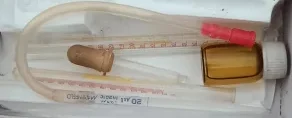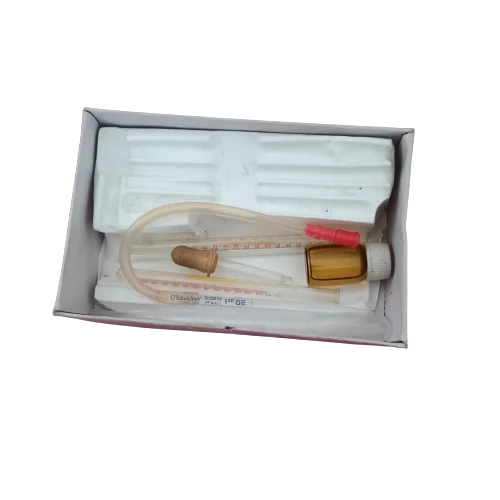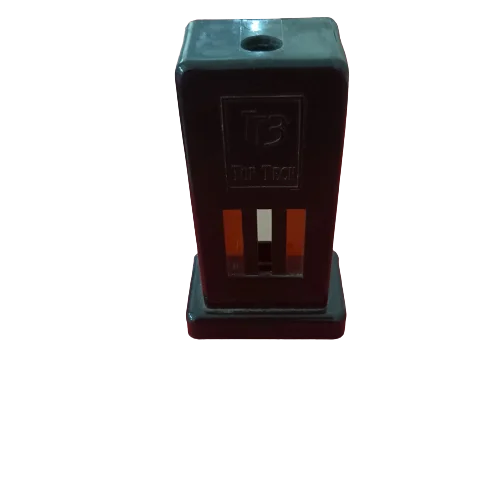Aim: Estimation of blood haemoglobin by Sahli’s or acid haematin method
Summary:
Haemoglobin is a conjugated protein synthesized inside the immature erythrocyte in the red bone marrow it consists of two components 1. Heme ( iron + protoporphyrin ) and 2. globin (amino acid chain). It gives a red color to blood.
Principle:
When blood is added to 0.1 N hydrochloric acid, hemoglobin is converted to brown-coloured acid hematin. The resulting color after dilution is compared with standard brown glass Saheli haemoglobinmeter
Specimen:
Capillary blood or well-mixed EDTA anticoagulated venous blood. The specimen need not be a fasting sample when blood is stored in the refrigerator at 2 to 8 degrees Celsius, hemoglobin remains unchanged.
Procedure:
- By using a Pasteur pipette add 0.1 N hydrochloric acid in the tube up to the lowest mark (20% mark)
- Draw blood up to 20 Micron liter mark in the Hb pipette. Adjust the blood column carefully without bubbles. Wipe excess blood on the side of the pipette using dry pieces of cotton or tissue paper.
- Transfer blood to the acid in the graduated tube, mix with the help of a glass rod, and allow the tube to stand for at least 10 minutes
- Diluted the solution with distilled water by adding a few drops at a time carefully and by mixing the reaction mixture, until the color matches the glass plate in the comparator
Note:
The matching should be done only against natural light the level of the fluid is noted at its lower meniscus and the reading corresponding to this level on the scale is recorded
Normal Value:
- Male 13 – 18 g/dl
- Female 12 – 16 g /dl
- Infants 13 – 20 g /dl
Clinical Significance:
- A decrease in hemoglobin below the normal range indicates anemia. Hemoglobin concentration drops during pregnancy due to hemodilution
- An increase in hemoglobin concentration occurs in hemoconcentration due to loss of body fluid in severe diarrheic and vomiting. High values are also observed in congenital heart disease ( Due to reduced oxygen supply )
Advantage:
- Simple bedside test.
- Reagent and apparatus are cheap
Disadvantage:
- Methemoglobin, carboxyhemoglobin, and sulfhemoglobin are not converted to acid hematin by N/10 HCL.
- It can give an error of up to 1 g/dl
- Comparators can fade over the year.
- There can be visual error
Precaution:
- Immediately after using Rinse the Hb pipette using tap water in a beaker. This prevents blocking of the pipette
- Don’t mouth pipetting
Also Read:
- Bile Salt (Hay’s Sulphur Method)
- Estimation of occult blood in stool by Benzidine method.
-
“Unlocking the Secrets of Urine: A Comprehensive Guide to Urine Examination”
- Glucosuria (Benedict Method)
- Ketone Body (Rotheras, Gerhardt’s and Strip Method)
- Proteinuria (Heat and acetic acid, Sulphur Salicylic Acid, Hellers or Nitric acid, and Esbach albuminometer Method)

- Bence Jones Proteinuria (HCl Method)
- Urobilinogen (Ehrlich Method)
- Bile Pigment (Fouchets Method)
- Occult Blood (Orthotoluidine and Benzidine Method).
- Sedimentation Preparation
- Slide Preparation
- Microscopic Examination.
Reference
“Hoffbrand’s Essential Haematology” by A. Victor Hoffbrand, Paul A.H. Moss, and John E. Pettit: This is a comprehensive and highly regarded textbook that covers the fundamental principles of hematology.
“Williams Hematology” by Kenneth Kaushansky, Marshall A. Lichtman, Josef T. Prchal, Marcel M. Levi, Oliver W. Press, and Linda J. Burns: This is a renowned textbook that provides in-depth coverage of both clinical and basic aspects of hematology.
“Wintrobe’s Clinical Hematology” by John P. Greer, Daniel A. Arber, Bertil E. Glader, Alan F. List, Robert T. Means Jr., Frixos Paraskevas, George M. Rodgers, and Michael H. Schmitt: This classic text has been a staple in the field of hematology for many years and offers comprehensive information on various hematological disorders.
“Hematology: Basic Principles and Practice” by Ronald Hoffman, Edward J. Benz Jr., Leslie E. Silberstein, Helen Heslop, John Anastasi, and Jeffrey Weitz: This textbook provides a detailed overview of the principles and practice of hematology, including the latest advancements in the field.
“Clinical Hematology and Fundamentals of Hemostasis” by Denise M. Harmening: This book is a good choice for those looking for a comprehensive guide to both clinical hematology and hemostasis.
“Rodak’s Hematology: Clinical Principles and Applications” by Elaine M. Keohane, Larry Smith, and Jeanine M. Walenga: This text focuses on the clinical application of hematology concepts and includes practical information for laboratory professionals.
“Hematology in Clinical Practice” by Robert S. Hillman, Kenneth A. Ault, and Henry M. Rinder: This book is designed for healthcare professionals and provides a practical approach to hematology in a clinical setting.
“Consultative Hematology: An Issue of Hematology/Oncology Clinics of North America” edited by Mikkael A. Sekeres and Christopher R. Cogle: This book focuses on the consultative aspects of hematology and is a valuable resource for clinicians.

